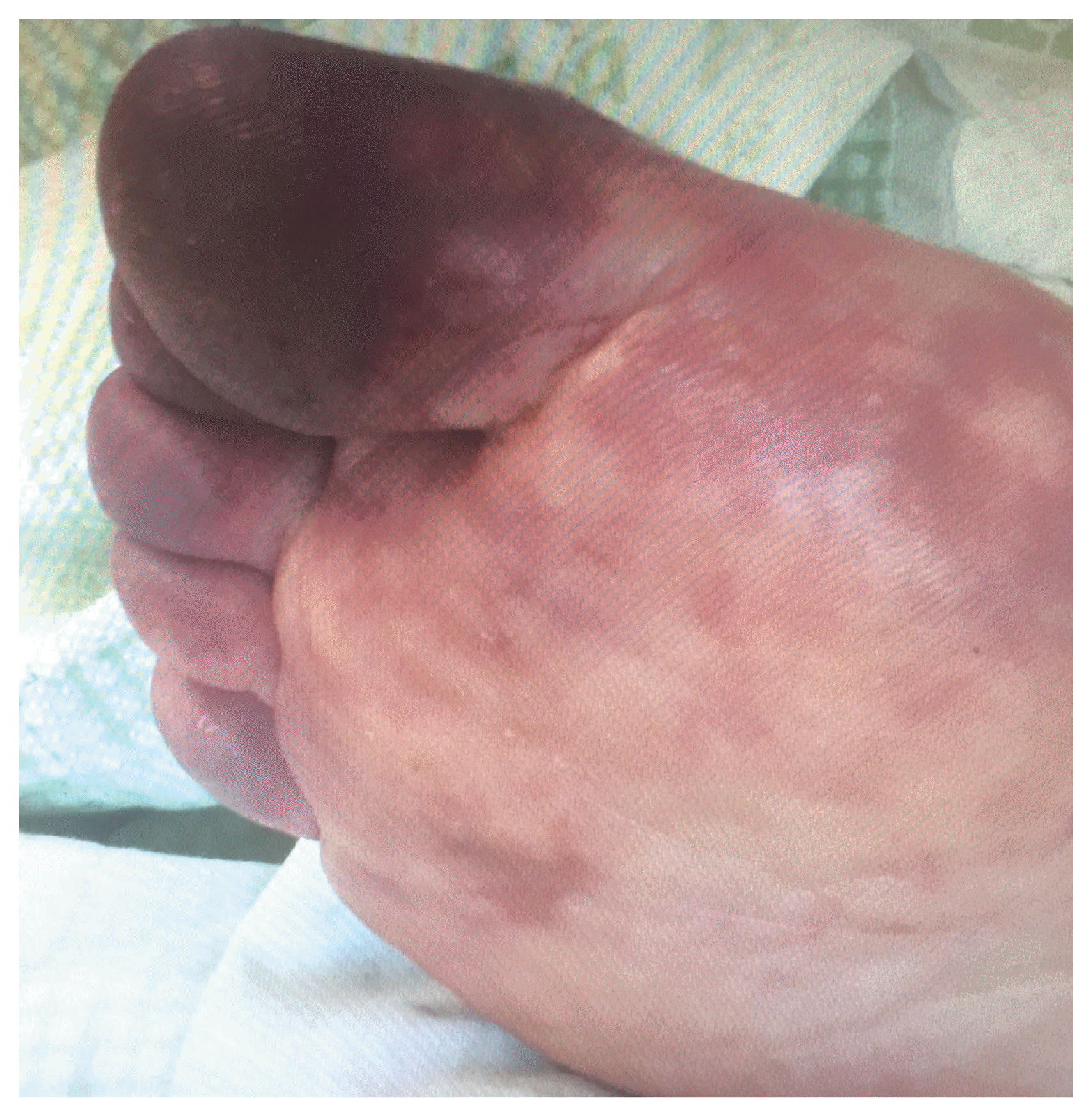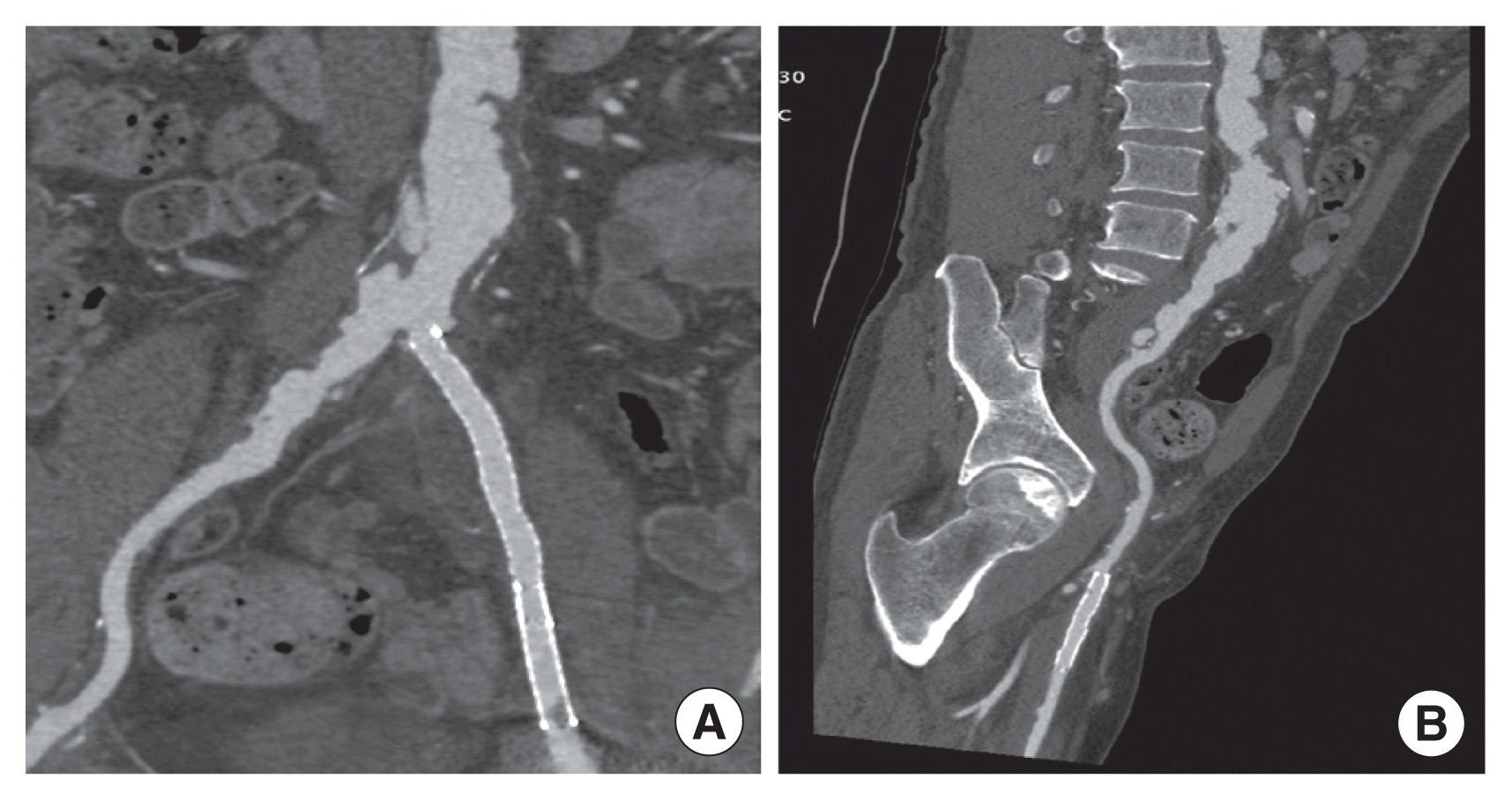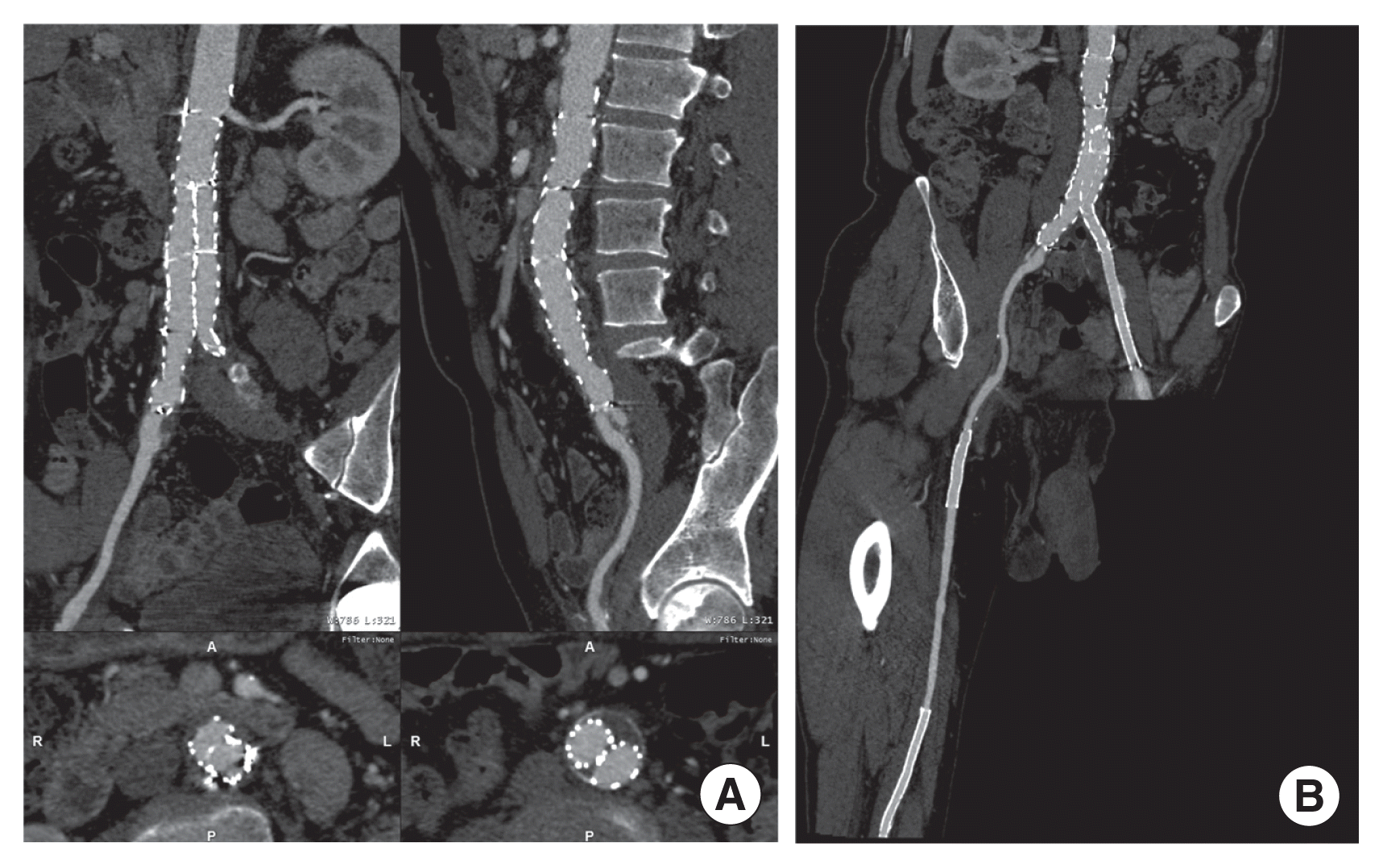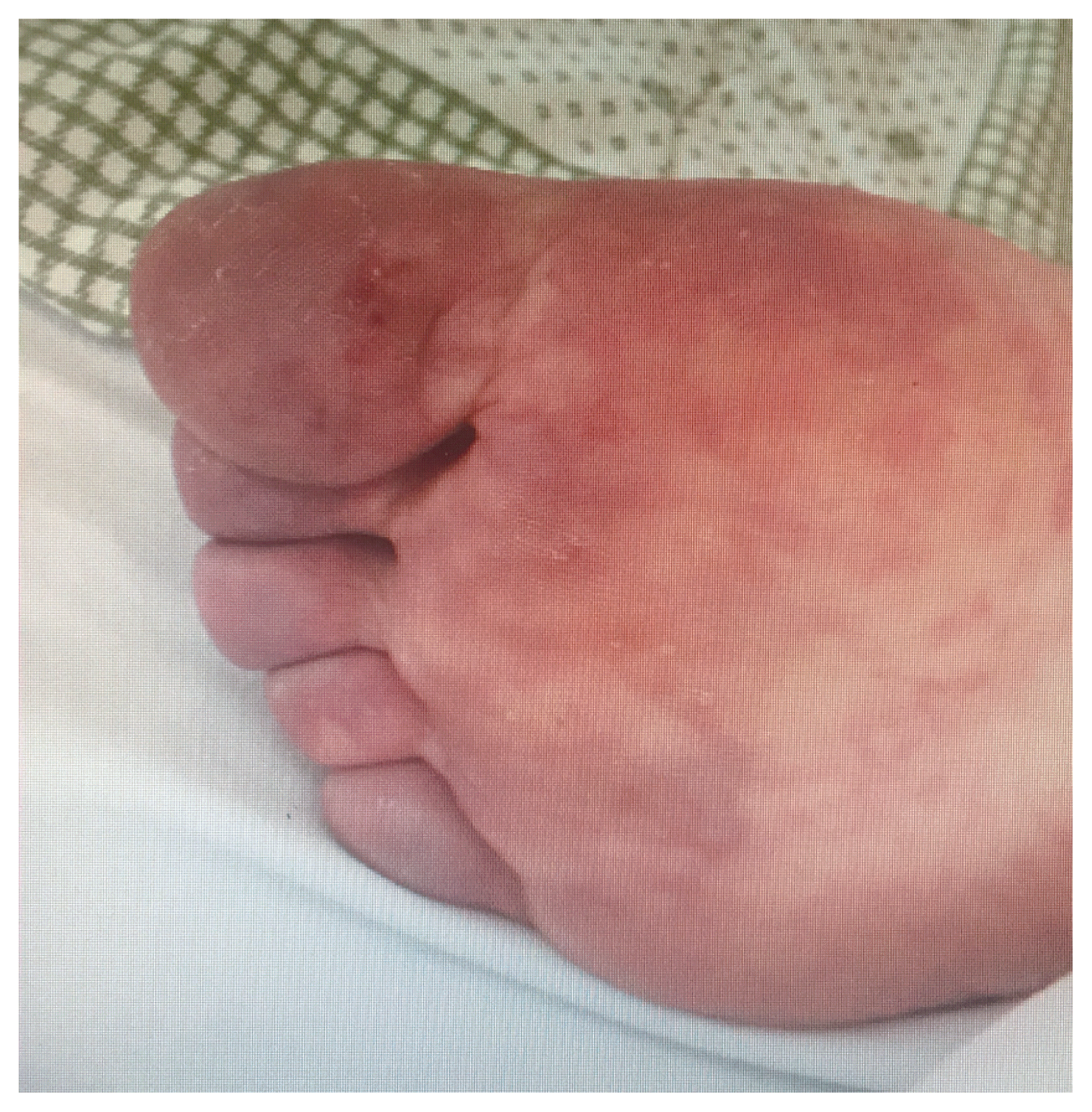INTRODUCTION
The blue toe syndrome is characterized by tissue ischemia secondary to cholesterol crystal or atherothrombotic embolization leading to occlusion of small vessels. Embolization occurs typically from an ulcerated atherosclerotic plaque located in the aorto-iliac-femoral arterial system with or without aneurysm [1].
The important clinical manifestation was a spontaneous onset of a painful bluish discoloration of the toes, without vasospasm and with skin lesions related to the occluded artery which happened frequently on elderly patient. Diagnosis is usually (definitely) confirmed with skin or muscle biopsy and fundoscopic examination presenting cholesterol crystals [2].
The differential diagnosis can be divided into three categories: emboli from the cardiac and arterial system, acquired hypercoagulability disorders, and syndromes that lead to peripheral vascular pathology [2].
Aneurysms, atherosclerotic disease, and microemboli due to acquired hypercoagulative disorders are the common causes of blue toe syndrome. Aneurysms located on the aorto-iliac and/or femoro- popliteal arterial system and the ulcerated atherosclerotic plaque can typically lead to embolization, which manifests spontaneously [3].
The goals of treatment are 2-fold: supportive care for end-organ damage (if exist) and secondary prophylaxis against another episode of cholesterol embolization syndrome. Because cholesterol embolization syndrome is a manifestation of atherosclerosis, modification of traditional risk factors such as smoking, hypertension, and serum cholesterol should be advised strongly [4].
CASE REPORT
A smoking 57-year-old man presented at the emergency department of Soonchunhyang University Bucheon Hospital with acute painful and cyanosis toes of left and right foot. His past medical history included arterial hypertension, diabetes mellitus, coronary artery disease (left circumflex and right coronary artery), and peripheral arterial disease. One year ago, chronic total occlusion of right coronary artery was successfully recanalized. One month ago, percutaneous transluminal angioplasty and stenting was performed in the right femoral artery and left iliac artery, respectively. When he was discharged from the hospital, mild blue toe was observed and managed with medical treatment. The patient was afebrile, and the remaining vital signs were normal.
Examination revealed normal pulse to pedal level bilaterally. Cyanosis with livedo reticularis were evident especially 1st and 2nd toes of right foot (Fig. 1). Ankle brachial pressure index on the right measured 1.03, and on the left was 0.86. Blood test showed (November 2, 2015): white blood cell, 9.34×103/μL; hemoglobin, 12.2 g/dL; platelet, 222×103/μL; albumin, 3.6 g/dL; glucose, 125 mg/dL; aspartate aminotransferase, 19 IU/L; alanine aminotransferase, 9 IU/L; creatinine, 0.9 mg/dL; blood urea nitrogen, 13.3 mg/dL; Na, 143 mmol/L; K, 3.7 mmol/L; and Cl, 103 mmol/L.
Electrocardiogram on admission showed sinus rhythm, and transthoracic echocardiography showed the preserved left ventricular systolic function with regional wall motion abnormality on territory of right coronary artery but no intracardiac thrombus. Angio-computed tomography (CT) scan revealed the normal dimension of aorta but present the irregular atherosclerotic ulceration on lower abdominal aorta with extension to proximal portion of right common iliac artery (CIA) (Fig. 2).
The initial management of our patient is medical treatment, which consists statin and cardiovascular risk factor modification (stop smoking). Because of the high risk of recurrent embolism and favorable anatomy characteristics, the patient was decided to treat with stent graft coverage. The coverage was planned from intrarenal abdominal aorta to both proximal parts of common iliac arteries. The patient underwent endovascular aortic repair with Endurant stent graft (25-16-124 mm on lower abdominal aorta; 16-20-93 mm on right CIA; 16-10-124 mm on left CIA; Medtronic Vascular, Santa Rosa, CA, USA) (Fig. 3).
Hospital length of stay was 5 days after the intervention. There are no perioperative complications, especially no iatrogenic embolic event by procedure. Angio-CT scan control showed successful placement of stent graft in lower abdominal aorta and right and left proximal CIA. Multiple ulceration of the previously seen in lower abdominal aorta is no longer visible. One month later, pedal pain and cyanosis resolved, but some livedo reticularis persisted on the right foot (Fig. 4).
DISCUSSION
Blue toe syndrome usually occurs on elderly patient with thoracoabdominal aneurysms. However, it also can be caused by high risk atheromatous aorta. Aortic plaques may give rise to two types of emboli: thromboemboli and atheroemboli (cholesterol crystal emboli). Thromboemboli are relatively large, tend to occlude medium to large arteries, and cause strokes, transient ischemic attacks, and renal infarcts and other forms of peripheral thromboembolism. Cholesterol crystal emboli are relatively minute, tend to occlude small arteries and arterioles, and may cause the blue toe syndrome, new or worsening renal insufficiency, gut ischemia, etc. [5]. In our patient, the cause of his blue toe was secondary from the embolization of aorto-iliac artery system (atheroemboli or cholesterol crystal emboli).
Beside the conventional medical treatment by antithrombotic and cardiovascular risk factors modification, therapeutic goal for blue toe syndrome consists of surgical or percutaneous elimination of the source of embolism. The decision regarding the type of intervention was not easy.
Surgical plaque removal (endarterectomy) or exclusion of the plaque (ligation and bypass, endovascular exclusion) may be indicated if a clear embolic source is identified, the source is surgically accessible, and the patient is an appropriate candidate for surgery [3,6,7].
Endovascular aortic repair by stent graft coverage emerges as alternative treatment option for blue toe syndrome. The stent-graft is positioned overlying the atheromatous plaque to exclude it from the circulation, thus preventing subsequent embolization. The endovascular approach is an alternative to open surgery and an attractive option for patients who are poor candidates for surgery; however, potential disadvantages include the potential for iatrogenic embolization due to manipulation of catheters in the region of the lesion and complications related to intravenous contrast [8].
One single-institution retrospective study was conducted by Jeyabalan et al. [9] using endovascular strategies for treatment of 25 cases who suffered from embolizing thoracoabdominal aortic lesions. This study showed no operative deaths. There were no embolic events found during the procedure, nor detected on follow-up. One procedure-related complication was a groin wound seroma that was treated with open drainage 1 month after surgery. No patient had spinal cord ischemia. The 1-year mortality rate was 25%. Of the five patients who died during follow-up, three died of pulmonary pathology (pneumonia, pulmonary fibrosis), one had a hematologic malignancy (acute myeloid leukemia), and the other was of unknown etiology. The study concluded that endovascular coverage of atheroembolic sources in the aorta is feasible and is safe and effective in properly selected patients. It does not appear to worsen renal function when performed with the use of specific technical strategies [9].
In another one study, Renshaw et al. [3] used percutaneous angioplasty with stenting for eight patients with unilateral blue toe syndrome and 12 hemodynamically significant lesions: four in the superficial femoral artery, six in the common iliac, and two in the external iliac. They concluded on the basis of intermediate results that angioplasty and stenting are a reasonable alternative to standard operative approaches [3].
In conclusion, endovascular stent graft is a relatively new treatment option to the traditional surgical procedure for management of blue toe syndrome caused by aorto-iliac cholesterol crystal embolism. This procedure is feasible, safe, and effective in properly selected patients in experienced center.















